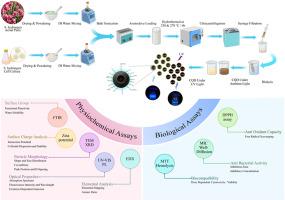Salvia hydrangea-derived carbon quantum dots via sustainable synthesis: Unraveling physicochemical properties, biocompatibility, and biological efficacy
IF 6.8
3区 材料科学
Q1 MATERIALS SCIENCE, MULTIDISCIPLINARY
Journal of Science: Advanced Materials and Devices
Pub Date : 2025-10-14
DOI:10.1016/j.jsamd.2025.101028
引用次数: 0
Abstract
Carbon quantum dots (CQDs) are biocompatible, water-soluble nanoparticles with tunable photoluminescence properties. Their green synthesis from medicinal plants offers an eco-friendly and cost-effective approach while enabling surface functionalization with plant-derived bioactive compounds. Salvia hydrangea and its cell cultures have recently been reported as rich sources of rosmarinic acid. In this study, plant aerial parts and cell cultures (as renewable precursors) were employed for the first time to synthesize CQDs via a one-step hydrothermal method. The nanoparticles were characterized by FTIR, EDX, XRD, TEM, Zeta potential, and UV–Vis spectroscopy, and their antimicrobial, antioxidant, and cytotoxic activities were evaluated. The average size of CQDs synthesized from plant aerial parts (pCQDs) and cell cultures (cCQDs) was 3.7 ± 2.3 nm and 2.9 ± 1.9 nm, respectively, showing distinct particle size distributions. With abundant N-containing and O-rich groups on their surfaces, the CQDs exhibited good solubility in water. Moreover, zeta potential values for pCQDs (+15.7 mV) and cCQDs (−54.9 mV) indicated a significant difference in surface charge. Despite the higher colloidal stability and superior optical properties of cCQDs (QY = 8.3 %), pCQDs demonstrated stronger antibacterial activity, particularly against Staphylococcus aureus. pCQDs also showed greater free radical scavenging activity than Trolox. Both types of CQDs exhibited low cytotoxicity toward fibroblast cells and did not cause significant hemolytic effects in human red blood cells. These findings highlight the influence of different plant tissues on the physicochemical and biological properties of CQDs and suggest their diverse application potential.

通过可持续合成的鼠尾草绣球衍生的碳量子点:揭示物理化学性质,生物相容性和生物功效
碳量子点(CQDs)是具有可调光致发光特性的生物相容性水溶性纳米粒子。他们的绿色合成从药用植物提供了一种环保和经济有效的方法,同时使表面功能化与植物来源的生物活性化合物。绣球鼠尾草及其细胞培养物最近被报道为迷迭香酸的丰富来源。本研究首次采用植物空中部分和细胞培养物(可再生前体)一步水热法合成CQDs。采用FTIR、EDX、XRD、TEM、Zeta电位和UV-Vis光谱对纳米颗粒进行了表征,并对其抗菌、抗氧化和细胞毒活性进行了评价。由植物地上部(pCQDs)和细胞培养(cCQDs)合成的CQDs的平均尺寸分别为3.7±2.3 nm和2.9±1.9 nm,粒径分布明显不同。CQDs具有丰富的含氮和富氧基团,在水中具有良好的溶解性。此外,pCQDs的zeta电位值(+15.7 mV)和cCQDs的zeta电位值(- 54.9 mV)显示了表面电荷的显著差异。尽管cCQDs具有较高的胶体稳定性和优良的光学特性(QY = 8.3%),但pCQDs表现出更强的抗菌活性,特别是对金黄色葡萄球菌的抗菌活性。pCQDs也比Trolox具有更强的自由基清除能力。两种类型的CQDs对成纤维细胞均表现出较低的细胞毒性,并且对人红细胞没有显著的溶血作用。这些发现强调了不同植物组织对CQDs的理化和生物学特性的影响,并表明了CQDs的多种应用潜力。
本文章由计算机程序翻译,如有差异,请以英文原文为准。
求助全文
约1分钟内获得全文
求助全文
来源期刊

Journal of Science: Advanced Materials and Devices
Materials Science-Electronic, Optical and Magnetic Materials
CiteScore
11.90
自引率
2.50%
发文量
88
审稿时长
47 days
期刊介绍:
In 1985, the Journal of Science was founded as a platform for publishing national and international research papers across various disciplines, including natural sciences, technology, social sciences, and humanities. Over the years, the journal has experienced remarkable growth in terms of quality, size, and scope. Today, it encompasses a diverse range of publications dedicated to academic research.
Considering the rapid expansion of materials science, we are pleased to introduce the Journal of Science: Advanced Materials and Devices. This new addition to our journal series offers researchers an exciting opportunity to publish their work on all aspects of materials science and technology within the esteemed Journal of Science.
With this development, we aim to revolutionize the way research in materials science is expressed and organized, further strengthening our commitment to promoting outstanding research across various scientific and technological fields.
 求助内容:
求助内容: 应助结果提醒方式:
应助结果提醒方式:


